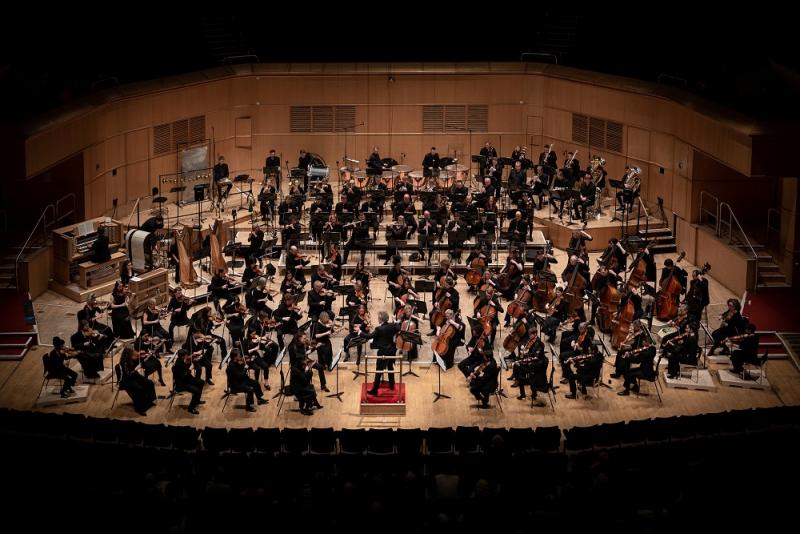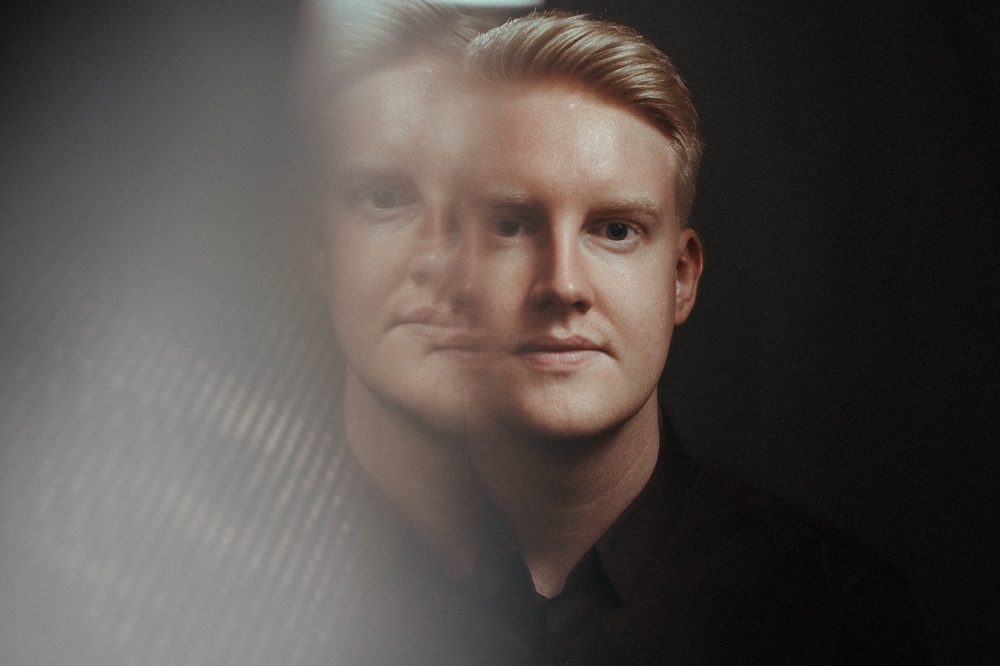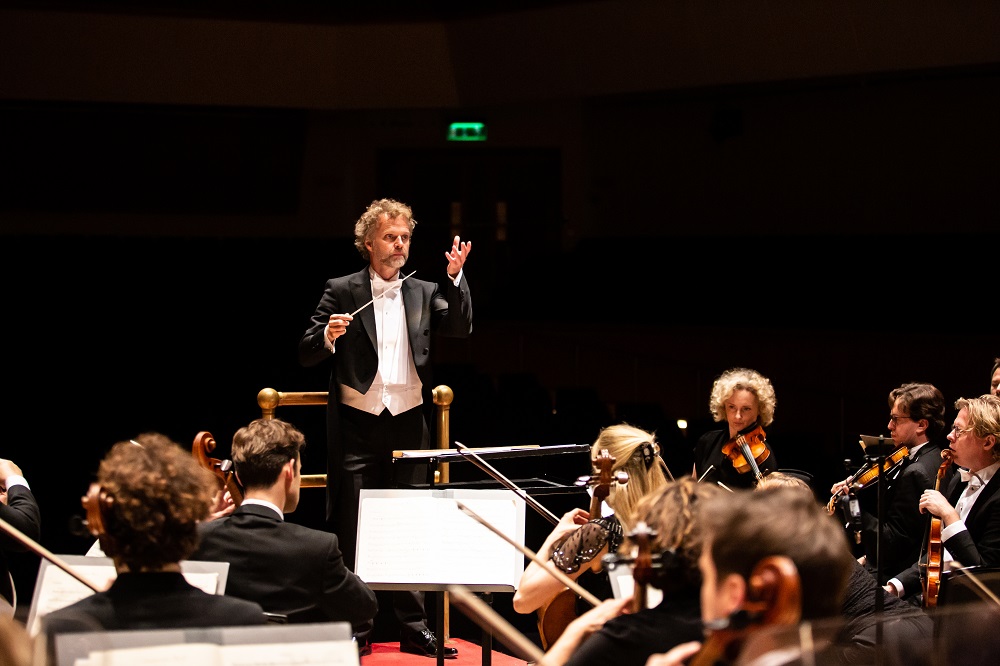RSNO, RCOS Students, Søndergård, Usher Hall, Edinburgh - a massive gesture of solidarity | reviews, news & interviews
RSNO, RCOS Students, Søndergård, Usher Hall, Edinburgh - a massive gesture of solidarity
RSNO, RCOS Students, Søndergård, Usher Hall, Edinburgh - a massive gesture of solidarity
From Scottish maelstrom and Norwegian trolls to a Bavarian mountain-top

In my last review from Edinburgh, I remarked on the sheer size of the National Youth Orchestra of Scotland, with over 100 players on stage.
But that was after the interval. The RSNO began the evening, the first I have been to since mask-wearing ceased to be a legal requirement, at conventional strength with a piece called Fèin-Aithne by the young Scottish composer Jay Capperauld (pictured below by Euan Robertson), which was first performed in 2016 by the BBC Scottish. The title is Gaelic, and translates as Self-Identity – in his programme note Capperauld explains how he tries to “explore, interpret and adapt my relationship to Scotland” while challenging the “accepted constructs, notions and preconceived stereotypes associated with the defined identity of Scottish Culture.”
That’s a lot of soul-searching to squeeze into a 12 minute piece, but luckily Capperauld has a finer grasp of orchestral nuance than his sententious prose would suggest. He adds that the piece will be continually updated to reflect his current viewpoint – a novel approach that aligns the world of composition to that of the mobile phone. This version was revised in 2022, and begins with an all-out assault from every section of the orchestra, a wall of sound underpinned by motoric rhythms and a pounding bass drum.  Under Thomas Søndergård’s crisp direction (the conductor pictured below by Sally Jubb), it's quite impressive: in the barrage of sound you can pick out fleetingly rich harmonies, folk tunes, a jig or two, eddies of interest swept along by an almost unstoppable flood of noise. When it does die down, fleetingly, there are moments of rare orchestral magic. Harp, celesta and ethereal percussion rise above the orchestral tapestry, much as a river plunges over a waterfall only to become, ten yards downstream, a babbling brook again.
Under Thomas Søndergård’s crisp direction (the conductor pictured below by Sally Jubb), it's quite impressive: in the barrage of sound you can pick out fleetingly rich harmonies, folk tunes, a jig or two, eddies of interest swept along by an almost unstoppable flood of noise. When it does die down, fleetingly, there are moments of rare orchestral magic. Harp, celesta and ethereal percussion rise above the orchestral tapestry, much as a river plunges over a waterfall only to become, ten yards downstream, a babbling brook again.
The Swedish composer Hugo Alfvén is not that well known on the British concert platform, though his Bergakungen Suite has a robust following at home. Extracted from the eponymous ballet, which translates as The Mountain King, the suite has four short colourful movements lasting about 16 minutes. "Bersvarjelse" (Invocation) hints at the strident rhythmic drive of Stravinsky, "Trollfickans dans" (Dance of the Troll Maiden) gets to the verge of a passionate romance, "Sommarregn"(Summer Rain) is a magical watery portrait, and "Vallflickans dans" (Dance of the Shepherd Girl) is a lighthearted whirlwind, punctuated by three insistently repeated notes, that is a popular encore piece in Sweden. I was reminded of the same composer’s much more famous Swedish Rhapsody.  And so to Strauss: An Alpine Symphony has always sat slightly apart from the composer’s other tone poems, being by turns popularly picturesque, sumptuously gorgeous, effortlessly tuneful, frighteningly demonic, and underlaid by Hammer Horror interjections from a large organ – a rare opportunity for the Usher Hall’s fine civic instrument to breathe heavily over us all. Did such an already over-the-top piece benefit from an extra 50 or so players from the national conservatoire? In terms of sheer volume, the effect was noticeable, almost to the point of reaching sonic saturation in the hall. But this was more than a simple exercise in vastness, it was above all a gesture of hope and solidarity from one fine musical organisation to another, a beacon of expectation that these fine young players, who have scarcely known any sort of public performance these last two years, will in due course be able to put masks and Covid behind them and take to the world’s concert platforms like the generations before them.
And so to Strauss: An Alpine Symphony has always sat slightly apart from the composer’s other tone poems, being by turns popularly picturesque, sumptuously gorgeous, effortlessly tuneful, frighteningly demonic, and underlaid by Hammer Horror interjections from a large organ – a rare opportunity for the Usher Hall’s fine civic instrument to breathe heavily over us all. Did such an already over-the-top piece benefit from an extra 50 or so players from the national conservatoire? In terms of sheer volume, the effect was noticeable, almost to the point of reaching sonic saturation in the hall. But this was more than a simple exercise in vastness, it was above all a gesture of hope and solidarity from one fine musical organisation to another, a beacon of expectation that these fine young players, who have scarcely known any sort of public performance these last two years, will in due course be able to put masks and Covid behind them and take to the world’s concert platforms like the generations before them.
rating
Explore topics
Share this article
Add comment
The future of Arts Journalism
You can stop theartsdesk.com closing!
We urgently need financing to survive. Our fundraising drive has thus far raised £49,000 but we need to reach £100,000 or we will be forced to close. Please contribute here: https://gofund.me/c3f6033d
And if you can forward this information to anyone who might assist, we’d be grateful.

Subscribe to theartsdesk.com
Thank you for continuing to read our work on theartsdesk.com. For unlimited access to every article in its entirety, including our archive of more than 15,000 pieces, we're asking for £5 per month or £40 per year. We feel it's a very good deal, and hope you do too.
To take a subscription now simply click here.
And if you're looking for that extra gift for a friend or family member, why not treat them to a theartsdesk.com gift subscription?
more Classical music
 Kempf, Brno Philharmonic, Davies, Bridgewater Hall, Manchester review - European tradition meets American jazz
Bouncing Czechs enjoy their Gershwin and Brubeck alongside Janáček and Dvořák
Kempf, Brno Philharmonic, Davies, Bridgewater Hall, Manchester review - European tradition meets American jazz
Bouncing Czechs enjoy their Gershwin and Brubeck alongside Janáček and Dvořák
 Solomon, OAE, Butt, QEH review - daft Biblical whitewashing with great choruses
Even a top soprano and mezzo can’t make this Handel paean wholly convincing
Solomon, OAE, Butt, QEH review - daft Biblical whitewashing with great choruses
Even a top soprano and mezzo can’t make this Handel paean wholly convincing
 Two-Piano Gala, Kings Place review - shining constellations
London Piano Festival curators and illustrious friends entertain and enlighten
Two-Piano Gala, Kings Place review - shining constellations
London Piano Festival curators and illustrious friends entertain and enlighten
 Echo Vocal Ensemble, Latto, Union Chapel review - eclectic choral programme garlanded with dance
Beautiful singing at the heart of an imaginative and stylistically varied concert
Echo Vocal Ensemble, Latto, Union Chapel review - eclectic choral programme garlanded with dance
Beautiful singing at the heart of an imaginative and stylistically varied concert
 Scott, Irish Baroque Orchestra, Whelan, RIAM, Dublin review - towards a Mozart masterpiece
Characteristic joy and enlightenment from this team, but a valveless horn brings problems
Scott, Irish Baroque Orchestra, Whelan, RIAM, Dublin review - towards a Mozart masterpiece
Characteristic joy and enlightenment from this team, but a valveless horn brings problems
 Classical CDs: Voice flutes, flugelhorns and froth
Baroque sonatas, English orchestral music and an emotionally-charged vocal recital
Classical CDs: Voice flutes, flugelhorns and froth
Baroque sonatas, English orchestral music and an emotionally-charged vocal recital
 Kanneh-Mason, Britten Sinfonia, Shave, Milton Court - a grin and a big beaming smile
A pair of striking contemporary pieces alongside two old favourites
Kanneh-Mason, Britten Sinfonia, Shave, Milton Court - a grin and a big beaming smile
A pair of striking contemporary pieces alongside two old favourites
 theartsdesk at the New Ross Piano Festival - Finghin Collins’ musical rainbow
From revelatory Bach played with astounding maturity by a 22 year old to four-hand jazz
theartsdesk at the New Ross Piano Festival - Finghin Collins’ musical rainbow
From revelatory Bach played with astounding maturity by a 22 year old to four-hand jazz
 First Person: Manchester Camerata's Head of Artistic Planning Clara Marshall Cawley on questioning the status quo
Five days of free events with all sorts of audiences around Manchester starts tomorrow
First Person: Manchester Camerata's Head of Artistic Planning Clara Marshall Cawley on questioning the status quo
Five days of free events with all sorts of audiences around Manchester starts tomorrow
 Goldscheider, Brother Tree Sound, Kings Place review - music of hope from a young composer
Unusual combination of horn, strings and electronics makes for some intriguing listening
Goldscheider, Brother Tree Sound, Kings Place review - music of hope from a young composer
Unusual combination of horn, strings and electronics makes for some intriguing listening

Comments
I attended the Glasgow